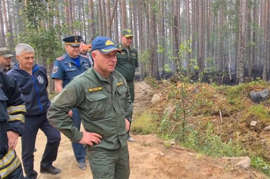
Evgeny Zinichev, RF Minister for Civil Defense, Emergencies and Elimination of Consequences of Natural Disasters (foreground).
Following the results of the elimination of the consequences of the emergency in Norilsk, which occurred in the spring of 2020, President Vladimirov Putin instructed, under the leadership of the Russian Emergencies Ministry, to conduct an interdepartmental exercise to protect the territories included in our Arctic zone.
The exercise will take place simultaneously in 7 constituent entities of the Russian Federation: Arkhangelsk and Murmansk regions, the Republics of Komi and Sakha (Yakutia), Krasnoyarsk Territory, Nenets and Chukotka Autonomous Districts. The cities of Norilsk and Dudinka were identified as the center of the exercise. It is here that the most ambitious exercise scenarios are planned to be played out. Here, in the town of Dudinka of the Krasnoyarsk Territory, a field camp of the Ministry of Emergencies will be deployed, where the headquarters of the Exercises will be located under the leadership of the Minister of the Ministry of Emergencies of Russia – Chairman of the Government Commission for the Prevention and Elimination of Emergencies and Ensuring Fire Safety, General of the Army Yevgeny Zinichev.
An important circumstance is the fact that in May 2021 Russia began its two-year chairmanship of the Arctic Council. The doctrine was included in the plan of the main activities of the Council. Recall that it includes 8 Arctic countries – Russia, Canada, Denmark, Finland, Iceland, Norway, Sweden, USA.
This is the first time that such an experimental research exercise will take place in the Arctic zone. All forces and means of the unified state system for the prevention and elimination of emergencies will demonstrate their “combat” readiness to protect the population and territory of our country from a wide range of emergencies.
What scenarios will work?
According to the first deputy head of the Russian Emergencies Ministry Alexander Chupriyan, an important feature of the upcoming exercises is their experimental and research nature: each scenario for the elimination of conditional emergencies is focused on improving existing or developing new rescue technologies in the Arctic. The RSChS group is testing the latest models of special equipment and technologies in real conditions, assessing the effectiveness of the tactics of the units' actions, taking into account climatic and territorial features and threats that are relevant for the region.
For example, they will conduct a study of the peculiarities of creating an interdepartmental grouping of forces and means for carrying out rescue operations related to the elimination of emergency oil spills. They will see how to evacuate passengers from ships in various ways. They will study the peculiarities of interaction during underwater work at potentially dangerous objects. They investigate the possibilities of localizing and eliminating a fire on a ship during the transportation of chemically hazardous substances and during the ignition of oil products. They will deal with the possibilities of ensuring the safety of people when extinguishing a fire in a medical institution with a hospital. And this is not the whole list of the research objectives of the exercises.
How will universities help?
For a high-quality scientific study of each introduction to the teachings, close interaction of universities and research organizations with the territorial bodies of the EMERCOM of Russia has been organized.
For example, in order to “carry out special underwater works at an underwater potentially hazardous facility in the water area of the port of Murmansk,” the University of St. Petersburg provides for approbation of the divers' tug “Factor”. In addition, negotiations are underway with the Okeanos Research and Production Enterprise of Underwater Technologies to use the samples of technical equipment presented at the Arctic Cluster of the Integrated Safety-2021 Salon. And scientific and methodological support of the introductory “Epizootic caused by the outbreak of anthrax” in Naryan-Mar is carried out by the All-Russian Research Institute of Civil Defense and Emergencies, taking into account the practical experience gained by the Institute's staff in 2016 in the elimination of the anthrax epizootic in the Yamal-Nenets Autonomous Okrug. This work involved the scientific and pedagogical staff of the Department of Biomedical and Environmental Protection of the Academy of Civil Protection and specialists of the management of the RChBZ Center “Leader”.
Three educational organizations are involved in scientific and methodological support in Norilsk and Dudinka: the Siberian Fire and Rescue Academy, the Ivanovo Fire and Rescue Academy and the Ural Institute of the State Fire Service of the Russian Emergencies Ministry. For the first time, it is planned to test the technology of laser cutting of the tank wall to ensure the supply of fire extinguishing agents, new alternative energy sources (gel batteries, solar panels) and technology for the use of fast-hardening foam. They will test technologies and means for pumping oil products into temporary storage tanks in the event of an OSR threat, etc. Rescuers and scientists will try to deal with wildfires – research will take place in the tundra near the settlement of Tiksi.
In addition to practicing practical actions, a business program is being prepared in Norilsk. And in each region, on the territory of which the exercises will be held, an exhibition exposition with a demonstration of machinery, equipment, outfit and gear will be deployed. The main exhibition exposition of the exercises in Norilsk is planned to be prepared jointly with the Ministry for the Development of the Russian Far East, the Ministry of Transport, the Ministry of Health, the Federal Security Service, the Russian Guard, the Ministry of Digital Science, FMBA and the state corporations Rosatom and Roskosmos. Also involved in this work are companies from the fuel and energy complex implementing economic and infrastructure projects in the Arctic, companies producing life support equipment, machinery, equipment and equipment for working in the Arctic zone.

